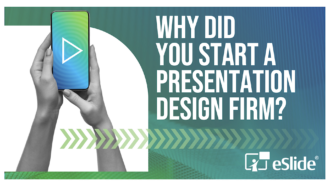Using Visuals in Your Business PowerPoint Presentation: Seeing Is Believing
Text and visuals are the building blocks of every business PowerPoint presentation. And although they are both useful, visuals have several distinct advantages over text.
In this post we look at why images have the advantage and how you can make them work for your presentation.
Cut Processing Time
The brain is primarily an image processor, not a word processor, so its consumption and comprehension of images happens a lot faster than it does with words. (This is why the section of the brain responsible for dealing with images is bigger than the section that deals with words.)
In our digital, always-on world, visual communication is preferred because it helps us distinguish valuable info from “background noise” in literally the blink of an eye. Case in point: the proliferation of image-based social media sites like Tumblr, Pintrest and Instagram.
Because our brains are working overtime to process all of the information we are constantly consuming, visuals are king. And this is true of business PowerPoint presentations too. Use visuals and the brains in your audience won’t have to work as hard, so your message will come through fast and easy.
Your Message Loud and Clear
In the presentation room, you want your audience’s undivided attention. And although they may be physically present, busy executive minds may be elsewhere, e.g., worrying about other projects or checking emails and texts on their smartphone.
You need to get your message across clearly to have the best chance of getting the results you want.
Visuals allow you to communicate complex ideas, relationships, patterns, facts or figures in an easily-digestible way. They allow you to ‘show’ rather than ‘tell’. Also, using visuals allows your audience to make connections for themselves, which means you have a lot less explaining to do.
With limited time and competition from other distractions, visuals will help you get and hold your audience’s attention – and will allow you to be more clear in your communication.
Use Your Imagination
Visuals allow the brain to, well, use its imagination, i.e., expand a concept beyond what’s in front of it. This is because visuals make the right hemisphere of your brain, the side responsible for intuitive thinking, kick into action. Your brain automatically interprets, expounds and builds on what it’s seeing.
For example, if you use an image of a handshake to represent a profitable new partnership, the brains in your audience will see not only the figures, but they’ll associate them with the positive emotion that a friendly handshake connotes.
The brain does not do the same with words on a page. In that case, what you see is what you get.
It’s Emotional
Visuals give the brain an easy way to connect with your message by generating emotion. Emotions help the brain retain information. And positive emotions have been shown to persuade people to act, e.g., sharing the information they’ve learned with others.
So the right visuals will not only help your audience remember your message, but also make them more likely to take action on it.
Finally, looking at images is not only easier, it’s more fun than looking at words. Think about what your brain wants after a long day at work. Maybe some people read War and Peace nightly, but for most of us, it’s the latest installment of Homeland every time.
Use Visuals Effectively
Visuals are an effective way to communicate, but as with any element of your business PowerPoint presentation, it’s important to remember that they are only one piece of the pie. And although they should be a big piece, they have to be used well to make maximum impact.
It’s important that the visuals you choose fit with your key message, otherwise the rules don’t work. In fact, the brain takes longer to process an image if it also has to figure out how the visual connects to the message being given.
Truth is, if you force the brain to make sense of two disparate items, i.e., message and irrelevant visual, it’ll take longer to process and will be less likely to retain the information. When this happens, your audience ends up confused.
Make sure your visuals support and reinforce your message rather than obscure, distort or simply repeat it. Every visual should have a communication goal; using non-topical visuals for decoration can ruin the chance of getting results from your business PowerPoint presentation.
Business PowerPoint Presentation Visuals Quick Tips
- Avoid poor-quality photos or whimsical clip-art. There are many great sources of royalty free stock art online.
- Don’t overdo it. Like any seasoning, if you overdo the visuals, they lose their impact. The idea is to use them to help clarify your key points – not every point.
- Consistency is an important aspect of a successful business PowerPoint Presentation, but don’t simply reuse the same visuals over and over. A consistent style is good, but not rote duplication.
- If you find you need a lot of words to explain a graphic, that is a good indication that it isn’t working. Consider replacing or reworking it, so it becomes more helpful.
- Color can make a strong statement, so be sure you’ve chosen ones that suit your message. You can learn more here.
Not sure how to make the best use of visuals in your business PowerPoint presentation? One of the design pros at eSlide will be happy to talk through the possibilities with you. We’ve created visuals for presentations for some of the biggest, most well-known companies in the world and we’d be glad to do the same for you. Contact us to learn how we can help!









